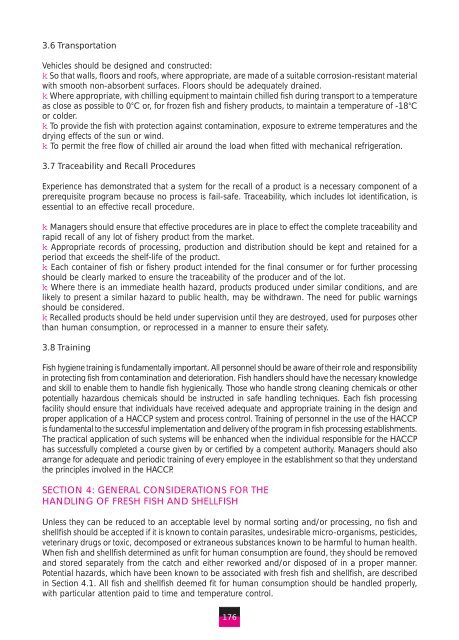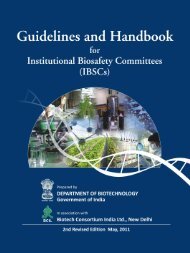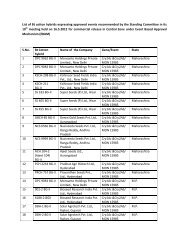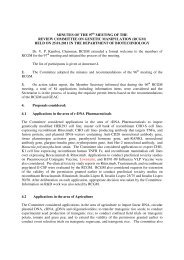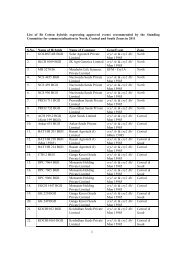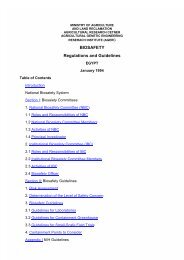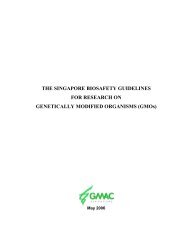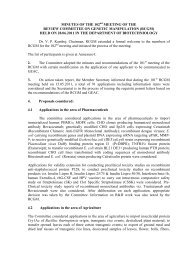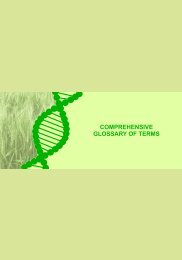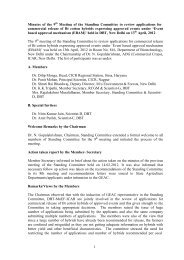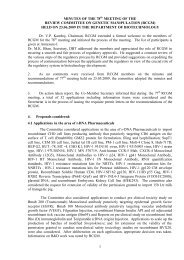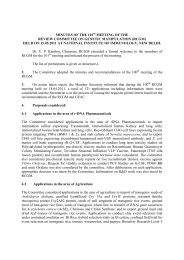THE USER'S MANUAL ON CODEX - Department of Biotechnology
THE USER'S MANUAL ON CODEX - Department of Biotechnology
THE USER'S MANUAL ON CODEX - Department of Biotechnology
You also want an ePaper? Increase the reach of your titles
YUMPU automatically turns print PDFs into web optimized ePapers that Google loves.
3.6 Transportation<br />
Vehicles should be designed and constructed:<br />
k So that walls, floors and ro<strong>of</strong>s, where appropriate, are made <strong>of</strong> a suitable corrosion-resistant material<br />
with smooth non-absorbent surfaces. Floors should be adequately drained.<br />
k Where appropriate, with chilling equipment to maintain chilled fish during transport to a temperature<br />
as close as possible to 0°C or, for frozen fish and fishery products, to maintain a temperature <strong>of</strong> -18°C<br />
or colder.<br />
k To provide the fish with protection against contamination, exposure to extreme temperatures and the<br />
drying effects <strong>of</strong> the sun or wind.<br />
k To permit the free flow <strong>of</strong> chilled air around the load when fitted with mechanical refrigeration.<br />
3.7 Traceability and Recall Procedures<br />
Experience has demonstrated that a system for the recall <strong>of</strong> a product is a necessary component <strong>of</strong> a<br />
prerequisite program because no process is fail-safe. Traceability, which includes lot identification, is<br />
essential to an effective recall procedure.<br />
k Managers should ensure that effective procedures are in place to effect the complete traceability and<br />
rapid recall <strong>of</strong> any lot <strong>of</strong> fishery product from the market.<br />
k Appropriate records <strong>of</strong> processing, production and distribution should be kept and retained for a<br />
period that exceeds the shelf-life <strong>of</strong> the product.<br />
k Each container <strong>of</strong> fish or fishery product intended for the final consumer or for further processing<br />
should be clearly marked to ensure the traceability <strong>of</strong> the producer and <strong>of</strong> the lot.<br />
k Where there is an immediate health hazard, products produced under similar conditions, and are<br />
likely to present a similar hazard to public health, may be withdrawn. The need for public warnings<br />
should be considered.<br />
k Recalled products should be held under supervision until they are destroyed, used for purposes other<br />
than human consumption, or reprocessed in a manner to ensure their safety.<br />
3.8 Training<br />
Fish hygiene training is fundamentally important. All personnel should be aware <strong>of</strong> their role and responsibility<br />
in protecting fish from contamination and deterioration. Fish handlers should have the necessary knowledge<br />
and skill to enable them to handle fish hygienically. Those who handle strong cleaning chemicals or other<br />
potentially hazardous chemicals should be instructed in safe handling techniques. Each fish processing<br />
facility should ensure that individuals have received adequate and appropriate training in the design and<br />
proper application <strong>of</strong> a HACCP system and process control. Training <strong>of</strong> personnel in the use <strong>of</strong> the HACCP<br />
is fundamental to the successful implementation and delivery <strong>of</strong> the program in fish processing establishments.<br />
The practical application <strong>of</strong> such systems will be enhanced when the individual responsible for the HACCP<br />
has successfully completed a course given by or certified by a competent authority. Managers should also<br />
arrange for adequate and periodic training <strong>of</strong> every employee in the establishment so that they understand<br />
the principles involved in the HACCP.<br />
SECTI<strong>ON</strong> 4: GENERAL C<strong>ON</strong>SIDERATI<strong>ON</strong>S FOR <strong>THE</strong><br />
HANDLING OF FRESH FISH AND SHELLFISH<br />
Unless they can be reduced to an acceptable level by normal sorting and/or processing, no fish and<br />
shellfish should be accepted if it is known to contain parasites, undesirable micro-organisms, pesticides,<br />
veterinary drugs or toxic, decomposed or extraneous substances known to be harmful to human health.<br />
When fish and shellfish determined as unfit for human consumption are found, they should be removed<br />
and stored separately from the catch and either reworked and/or disposed <strong>of</strong> in a proper manner.<br />
Potential hazards, which have been known to be associated with fresh fish and shellfish, are described<br />
in Section 4.1. All fish and shellfish deemed fit for human consumption should be handled properly,<br />
with particular attention paid to time and temperature control.<br />
176


